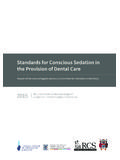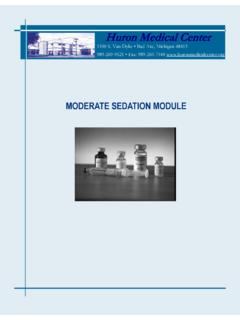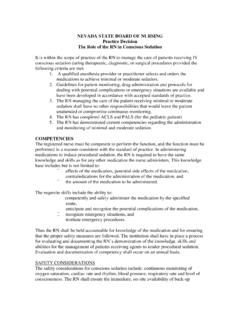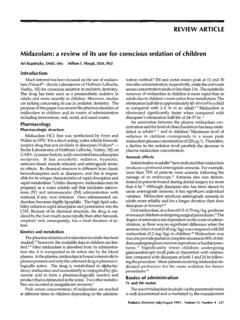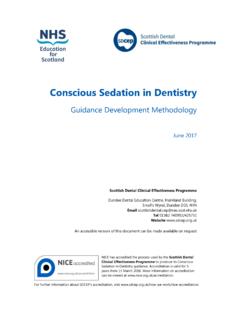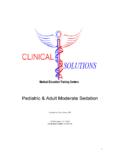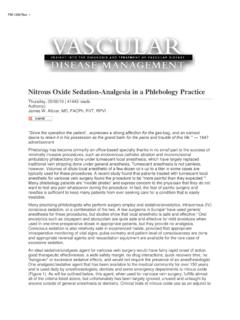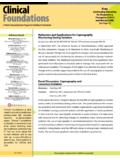Transcription of Conscious sedation - BAOS
1 Conscious sedationConscious Sedation23 De!nition of Conscious sedation 3 General anaesthesia 4 Conscious sedation techniques 5 Indications for Conscious sedation5 Responsibilities of the referring dentist5 Responsibilities of the treating dentist5 Patient assessment and selection6 Patient History6 Examination6 Contraindications 6 Consent7 Preparation of Patients7 Escort7 Facilities and equipment for sedation 8 Records and documentation 9 Aftercare9 Conscious sedation techniques11 Conscious sedation for children11 Inhalation sedation for children11 Intravenous sedation for children12 Conscious sedation for adults and children with special needs12 Management of complications 12 Safe use of midazolam 13 Training for Conscious sedation All patients deserve, and have a right to expect safe, appropriate pain and anxiety control whilst undergoing dental treatment. Competently provided Conscious sedation is a safe, effective and valuable tool in the management of patient anxiety.
2 This guidance provides information to help support dental practitioners and the wider dental team in the safe use of Conscious sedation techniques. The information contained represents a synthesis of Conscious sedation guidance currently available from other healthcare advisory sources, such as the Department of Health and the Scottish Dental Clinical Effectiveness Programme. It should not be seen as a definitive, stand-alone guideline in Conscious sedation and we strongly encourage readers to consult these other sources of information. Links to these sources and other relevant information is provided throughout this document by clicking on the blue highlighted BDA November 20113< contentsConscious sedation BDA November 2011De!nition of Conscious sedationThis is defined as; A technique in which the use of a drug or drugs produces a state of depression of the nervous system enabling treatment to be carried out, but during which verbal contact with the patient is maintained throughout the period of sedation .
3 The drugs and techniques used to provide Conscious sedation for dental treatment should carry a margin of safety wide enough to render loss of consciousness unlikely The definition of Conscious sedation given above describes the state of sedation , and does not attempt to prescribe how that state is achieved. There are a number of techniques involving the use of one or more drugs administered via different routes that will fulfil this definition provided that there is an adequate margin of the sedation method used, it is of fundamental importance that the level of sedation must be such that the patient remains Conscious and is able to both understand and respond to verbal commands during the entire sedation treatment session. Where patients are unable to communicate verbally in their normal, pre-sedated state (for example, deaf patients who use sign language to communicate); then their usual method of communication must be maintained throughout the entire sedation treatment session, from first administering the sedation agent through to patient is absolutely essential that a wide margin of safety be maintained between Conscious sedation and the unconscious state of general anaesthesia where verbal communication with the patient and protective reflexes are lost.
4 Any technique that results in the loss of consciousness is defined as general anaesthesia and in the UK, and the term deep sedation is considered within this category. It is important that there is a clear understanding by the patient (or where appropriate the parent or carer), the sedationist and all the dental team that Conscious sedation must under no circumstances be interpreted as light general anaesthesia. The practice of general anaesthesia under the guise of Conscious sedation is totally unacceptable and represents an extremely serious risk to patient anaesthesiaThe Department of Health report A Conscious Decision, published in 2000, led to the confinement of general anaesthesia for dentistry to within a hospital setting which has critical care facilities. This means that general anaesthesia cannot be provided within the primary care setting and must only be provided by someone who is: On the specialist register of the General Medical Council as an anaesthetist A trainee working under supervision as part of a Royal College of Anaesthetists approved training programme, or A non-consultant career-grade anaesthetist with an NHS appointment under the supervision of a named consultant anaesthetist, who must be a member of the same NHS anaesthetic department where the non-consultant career grade anaesthetist is anaesthetist should be supported by a health professional who is specifically trained and experienced in the necessary skills to help monitor the patient s condition and to assist in an settings which do provide general anaesthesia the recommendations set out in the Department of Health (England) publication A Conscious Decision a review of the use of general anaesthesia and Conscious sedation in primary dental care (July 2000)
5 And associated letters of advice from Chief Dental Officers in England, Northern Ireland, Scotland and Wales must be adopted. 4< contentsConscious sedation BDA November 2011 The Department of Health (England) guidance document Conscious sedation in the provision of dental care was published in 2003 and lays down specific recommendations for all practitioners providing Conscious sedation in general dental practice, community and hospital settings. It is a Standing Dental Advisory Committee (SDAC) report of an expert group on sedation for dentistry and is endorsed by the GDC s Standards for dental professionals. It underlines:1. The importance of the referring dentist and the sedationist considering alternative methods of pain and anxiety control and discussing these with the patient before deciding that Conscious sedation is appropriate2. The need for both theoretical and practical training, continuing updating and clinical audit for the whole dental team is stressed as part of the clinical governance framework for ensuring the delivery of a high quality service, and3.
6 The necessity of having the appropriate equipment and drugs and ensuring that the equipment is properly Scottish Dental Clinical Effectiveness Programme (SDCEP) has produced specific guidance on the provision of sedation in Scotland. Conscious sedation in dentistry dental clinical guidance was published in May 2006 and evolved from the report by the English Department of Health summarised above. Conscious sedation techniquesA range of techniques are available to produce the defined Conscious sedation state. The most commonly used method are inhalational sedation , using nitrous oxide and oxygen and intravenous sedation using a single benzodiazepine drug, usually Midazolam. These methods are safe and effective for the majority of patients who require sedation , however it is recognised that there is no one size fits all sedation technique and for many patients, these standard Conscious sedation techniques will not be effective and alternative (advanced) sedation techniques will need to be considered.
7 The Royal College of Surgeons of England-Faculty of Dental Surgery and the Royal College of Anaesthetists produced guidance in 2007, encompassing the use of alternative Conscious sedation techniques, entitled Standards for Conscious sedation in Dentistry: Alternative techniques-A Report from the Standing Committee on sedation for Dentistry . Such alternative techniques include: Any form of Conscious sedation for patients under the age of 12 years (or where physical and mental development of the individual does not correlate with their chronological age), other than nitrous oxide/oxygen inhalation sedation . Use of a benzodiazepine together with any other intravenous agent, opioids, propofol, ketamine Propofol either alone or with any other agent, benzodiazepine, opioid, ketamine Inhalational sedation using any other agent other than nitrous oxide/oxygen alone Combined (non-sequential) routes : intravenous plus inhalational agent (except for the use of nitrous oxide/oxygen during IV cannulation only) Oral and trans-mucosal ( intranasal) non-titratable techniques Standard techniques, using either nitrous oxide/oxygen or IV midazolam alone, are taught at undergraduate dental school level and are suitable for dentists to perform in primary care provided they are working within their competencies and keep their knowledge, experience and training in such techniques regularly up to date.
8 The alternative (advanced) sedation techniques described above must only be performed by dentist/seditionists with advance postgraduate training and experience in these techniques. Further information on training and education standards in Conscious sedation for the dental team is given at the end of this document. 5< contentsConscious sedation BDA November 2011 Indications for Conscious sedationConscious sedation may be indicated in the following circumstances: In anxious or phobic patients or those with movement disorder or with physical and/or mental disability who are unlikely to otherwise allow safe completion of treatment and who would thus be denied access to dental care For patients with a severe gag-reflex To enable an unpleasant or prolonged procedure to be carried out without distress to the patient, for example, surgical extraction of third molars or extirpation of an acutely inflamed dental pulp. It should be noted that intravenous sedation should never be used as a substitute for adequate pain relief using local anaesthesia in such cases.
9 To avoid general anaesthesia. The long term aim for patients in whom long term dental phobia could otherwise be induced or prolonged should be a graduated introduction of treatment under local anaesthesia if necessary using Conscious sedation as an intermediate is important to ensure that each exposure to Conscious sedation is justified on every occasion that its use is of the referring dentistBefore referring any patient for treatment under Conscious sedation , the referring dentist must discuss alternative methods of pain and anxiety management with the patient, such as the use of behavioural management techniques and the use of topical anaesthetic prior to giving local anaesthetics for patients who may seek sedation because of needle phobia. A description of the different types of Conscious sedation and how sedation is achieved will help the patient to understand what is practitioners must satisfy themselves that the care ultimately offered on referral is Conscious sedation according to the agreed definition.
10 Such assurance should be gained prior to the referral. This may involve local enquiries or even a visit to the practitioner to inspect is the duty of both the referring practitioner and the dentist providing treatment with sedation to encourage the patient to seek continuing dental care. Conscious sedation techniques for children are limited and for them this assurance takes on an even greater importance. The referral letter should include: Reasons and justification for the use of Conscious sedation , after consideration of alternative methods of pain and anxiety control. A full medical history which must be up to date. This can be a copy of notes made. Outline of dental treatment required. Relevant dental history Indication as to whether referral is for single procedure or whether the patient is being referred for all further note taking should include details of discussion with the patient. A copy of the referral letter must be kept.


